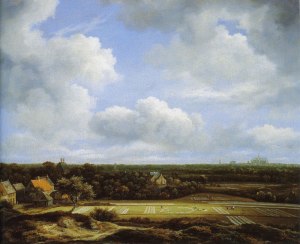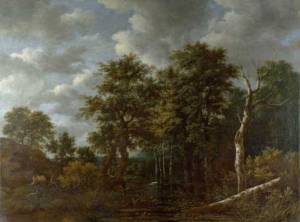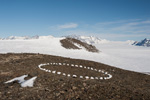Claude Lorrain (1600-1682): an influential landscape Artist of the Baroque, who influenced not only English landscape art, but also garden design and even literature. The romantic artists, J.M.W. Turner, John Constable and Samuel Palmer were influenced by him. I like the fact that he made myriads of drawings and sketches plein air before he decided on his final composition. This is something I like doing, but in my case the final paintings are invariably robbed of some of the directness and urgency of the rough sketches. My sketches can be lively and authentic, but often the finished painting can be quite stiff and dead.
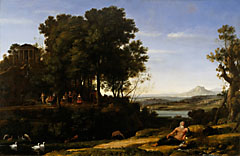
Image:Kind courtesy of http://www.arthistorynewsreport.blogspot.com accessed 28.08.2015
Jacob van Ruisdael:(1628-1682) was a Master landscape painter of the Dutch Golden Age. His early works were of the Flemish landscape with low horizons and dramatic skies. In 1650 after his move to Bentheim with it’s hilly landscape, he introduced ruins, craggy mountains, waterfalls, stormy skies, decaying trees as symbols of the transciency of life and human situations and to give a deeper sense of perspective. He intended to create paintings of mood by using his imagination. It was not a specific landscape or place that he wanted to depict, but a „sense of escapism“. These were moody, brooding dark images. After spending some time looking at his works I can perhaps admire his technical skill, but at the moment I cannot identify with those overly worked trees and boughs. I know that he is considered as „one of the greatest Old Masters of the 17th century, but I feel uneasy with so much precision as an all over effect, even more so as I learned that most of the objects which he introduced onto his landscapes were either appropriated or done according to a pattern or scheme. What I could emulate is the fact that he introduced new methods like impasto to create a certain 3-D effect.
1)View of the Plain of Haarlem with Bleaching Ground, early 1660s,. Image kind courtesy of http://www.pubhist.com accessed 28.08.2015
2)Pool surrounded by Trees, about 1665. Image Kind courtesy of http://www.nationalgallery.org/uk/artists/jacob-van-ruisdael Accessed 28.08.2015
J.M.William Turner(1775-1851): „The Painter of Light“ who raised landscape art to importance. I always have admired his beautiful skies and his treatment of light.
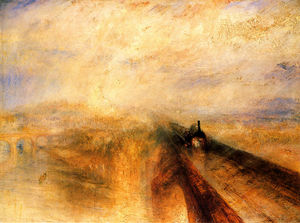 Rain, Steam and Speed by J.W.Turner, 1844
Rain, Steam and Speed by J.W.Turner, 1844
Image Kind courtesy of http://www.nationalgallery.org/uk/artists/joseph-mallord-william-turner Accessed 28.08.2015
John Constable (1776-1837): I like the fact that he concentrated on his immediate surroundings, his „Constable Country“, and that he loved painting his own places, which is also something I like to do, as I can return to these spots at different times of day, or year and sketch them in different light and seasons. I also like the fact that he painted scenes of ordinary life. Something very Morandi-like and humble about that. He said that imagination alone is insufficient and that reality is also vital. He too made many full scale sketches to check the composition before starting off on the final. That’s something I could adopt. He recorded weather conditions and wrote pertaining notes on the back of his studies – all inputs which I could introduce into my own practice.
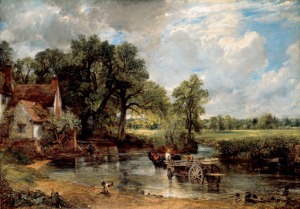 The Haywain, finished in 1821 Image Kind courtesy of http://www.nationalgallery.org/uk/artists/John-constable Accessed 28.08.2015
The Haywain, finished in 1821 Image Kind courtesy of http://www.nationalgallery.org/uk/artists/John-constable Accessed 28.08.2015
Ivon Hitchens(1893-1979) – panoramic landscapes with blocks of colour. I love these fields of colour with little or no detail.
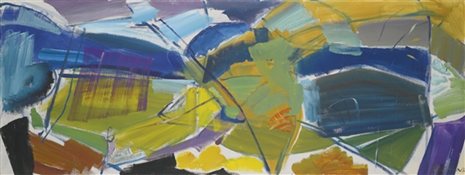 Lake Morning Light, Ivon Hitchens,ca 1970, oil on canvas. Image courtesy of http://www.alanwheatleyart.com Accessed 28.08.2015
Lake Morning Light, Ivon Hitchens,ca 1970, oil on canvas. Image courtesy of http://www.alanwheatleyart.com Accessed 28.08.2015
Peter Lanyon(1918-1964) A cornish landscapist – Abstract, vigorous brushstrokes and lots of my favourite blue. I find his an interesting body of work and must look at is work closely later.
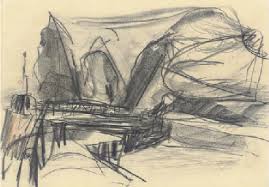
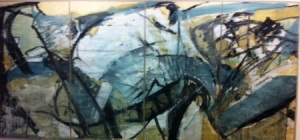 The Conflict of Man with Tides and Sands,Sketch for Liverpool University Mural, 1960, Gouache on paper. Image Kind courtesy of http://www.abstractcritical.com accessed 28.08.2015
The Conflict of Man with Tides and Sands,Sketch for Liverpool University Mural, 1960, Gouache on paper. Image Kind courtesy of http://www.abstractcritical.com accessed 28.08.2015
Richard Diebenkorn(1922-1993) – I love his interesting abstract landscapes, especially his inspiring ocean paintings.
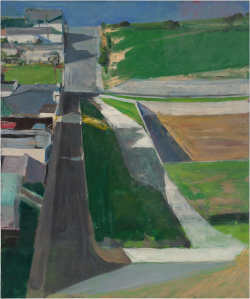 Cityscape#1, 1963 Illustration The Richard Diebenkorn Foundation accessed on 28.08.2015 on http://www.thegaurdian.com
Cityscape#1, 1963 Illustration The Richard Diebenkorn Foundation accessed on 28.08.2015 on http://www.thegaurdian.com
Research Point:
I looked at the work of Richard Long (1945-) a Land-art Artist who walks and measures using found objects to create his artworks.He never makes alterations to the landscape, but marks his chosen places with stones. He also paints with mud using his hands – like the women who paint their mudhuts with earthbased pigments using their hands. For him walking as art was his way of exploring time, distance, terrain somewhat like the aborogines during their walkabouts. I find his approach to use the pigments of the area to create very site-specific artworks interesting. I’d like to try this painting with mud approach when doing some artwalks along our local river. The mud would contain not only all the sludge, toxins and the negative imprint of man on nature, but also contain the DNA of the river – from source to point of extraction. I found this quite an interesting Approach and collected some mud from our river Isar to try out some experiments.
Another very interesting Land-art Artist I discovered was Andy Goldsworthy(1956-). He sets out with no idea what he wants to create and lets the materials he finds show him the way. He uses photography to record how his work grows and decays. He uses flower petals, icicles, leaves,mud, pinescones, snow, stone, twigs and even thorns to create. I like this idea of setting off with no preconceptions and using what one discovers to be inspired to create. These land artists are reverting to nature as a source of materials – like children who roam through their terrain letting their creativity run riot.
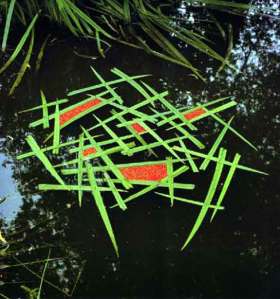
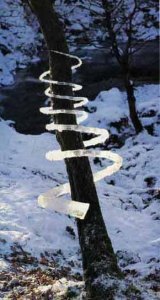 1) Andy Goldsworthy, Iris Leaves with Rowan Berries. 2) Ice Spiral – Treesoul both Images Kind courtesy of http://www.morning-earth.org accessed 28.08.2015
1) Andy Goldsworthy, Iris Leaves with Rowan Berries. 2) Ice Spiral – Treesoul both Images Kind courtesy of http://www.morning-earth.org accessed 28.08.2015
To round off this extensive list I would like to mention James Turrel(1943-) a US Land-Artist who works with space and light. His studio is the sky. (He happens to be a pilot too). He says: „We are living in a reality of our own creation“. and want to create „an experience of wordless thought“. He creates other-worldly light spaces – „landscapes without horizons“. I rather like this idea of moving into this realm of landscapes without horizons and of reducing art down to light. This gets me inspired to get back to my vast canvasses of blue.
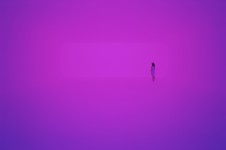 James Turrell, Breathing Light, 2013 Image Kind courtesy of http://www.jamesturrell.com Accessed 28.08.2015
James Turrell, Breathing Light, 2013 Image Kind courtesy of http://www.jamesturrell.com Accessed 28.08.2015
How could the artists I have researched influence my own work?
I like the recording Constable did on light, weather etc and that he did many preliminary sketches. I could adopt this discipline perhaps so that I could finish off work in my studio. I tend to do rather vague sketches. I actually prefer working plein air.
I love those blocks of colour on Ivon Hitchen’s work and feel encouraged to leave out detail and to carry on with my habit of using very broad brushes and enjoying my brushstrokes. But then I wont be learning anything new as this is something I like doing already.
Peter Lanyon’s work inspired me to carry on with my love of blues. Here again his vigorous brushstrokes also inspires me to unearth my broad brushes.
James Turrel’s saying: „a landscape without a horizon“ and his light-bathed spaces inspire me to create hugh canvasses of monocolour – with thirty or forty glazes to create a feeling of great depth. I cannot work with real light, but with pigments and glazes this astronauty feeling of weightlessness might be achieved. I remember some large canvasses which I had done some time ago using pure pigment and self ground Lapislazuli, turquoise and other waste semi-precious blue stones to create an expanse of weightless colour. It did have an unearthly effect on one. I didn’t think of them as landscapes before, but now I feel I must appropriate his expression and call them a landscape without a horizon.
I also like the idea of using found natural objects to create transient statements in nature. You make these objects out of what you find there, photograph it and then leave it there for nature to take it over again. Very ecological – no toxic paints, no plastics, no unnecessary waste.

